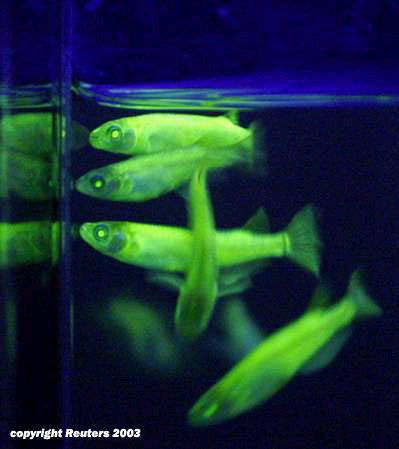
How Much Is that Transgenic Fish in the Window? Nov 24, 2003
Similar fish could also soon be available from fish food and equipment
giant Taikong of Taipei, Japan. This June, Taikong announced ... (Betterhumans, Canada)
Genetically Engineered Pets Hit the Market Nov 22, 2003
...psoriac writes "According to this article the Taiwanese Taikong Corporation is starting
to sell "Night Pearls" - zebrafish that glow in different red and green ... (Slashdot)
Excerpted from The Wall Street Journal :
:
Recent Biotechnology Innovation
Is a Bit Fishy: A Fluorescent Pet
By JASON DEAN
Staff Reporter of The Wall Street Journal
TAIPEI, Taiwan -- ... Fluorescent fish are just one of the latest off-the-wall innovations to come along in the biotechnology march. American researchers are seeking approval for a super-size salmon, retooled with growth hormones. A Canadian company, Nexia Biotechnologies Inc., is injecting spider genes into goats to produce milk that can be refined and woven into "BioSteel," for use in surgical sutures and "ballistic protection," the company says. ...
But Taikong's fish, which hit the market in Taiwan last month, may well be the world's first genetically modified house pets -- certainly the first designed to glow in the dark and one of the first leisure-time applications for genetic engineering. Born in a Taiwan biologist's lab in 2001 and written up in a scientific journal, the fish were soon discovered by Taikong, a 20-year-old company that sells aquarium equipment and fish food to shops around the world.
Willis Fang, Taikong's president, thought the appeal of the little green fish might go beyond research. He made plans to bring them to market as "Night Pearls," along with a whole line of products for the fish, such as black-lit tanks, fluorescent plastic coral and "fluorescent fish pellets" for food.
H.J. Tsai, a professor at National Taiwan University, with the glowing fish he created.
Word has traveled fast among aquarium enthusiasts. "If they can actually do this, it will be the greatest thing since popped corn," says Nevin Bailey, manager at Aquariumfish.net, a San Diego-based fish dealer who says customers have been asking him when they can buy glow-in-the-dark fish from Taiwan. "There's a lot of pent-up demand" for fluorescent fish in the U.S., he says, owing in part to articles about them in hobbyist magazines. Mr. Bailey, whose office is near a military base, sees a day when people will select their own color combinations. "My gosh, if they ever made one that was red, white, and blue, every Marine in the country would buy one."
The reaction in Europe, where resistance to genetic modification runs high, is different. "Fish shops in the U.K. won't touch them with a barge pole," predicts Derek Lambert, editor of Today's Fishkeeper, an enthusiasts' magazine. "There's a very strong anti-genetic-engineered-fish feeling in the U.K."
...
The fish started out as research tools, not pet store novelties. H.J. Tsai, a professor of fisheries science at National Taiwan University, stumbled on the innovation while working with genetically modified fish for medical research.
Like many biologists in his field, Prof. Tsai was using a fluorescent protein extracted from jellyfish as a genetic marker, attaching it to DNA in embryonic fish to make specific genes easier to see under a microscope. Laboratories elsewhere have produced partially fluorescent pigs, mice and insects.
Prof. Tsai also creates fish with fluorescent hearts, which researchers at the University of California at San Francisco use to monitor development of the fish organ -- useful for understanding human heart development, since humans and fish share a significant portion of their DNA. But two years ago, Prof. Tsai hatched a surprise: fish that showed the fluorescent color brightly in every cell.
At first, the glowing fish were an interesting sideline for the professor, but he didn't plan to sell them. He saw them as miniature ambassadors for science. "Kids see these fish and they're fascinated," he says, smiling through heavy-framed glasses. Executives at Taikong who already knew Prof. Tsai saw in the fish a fluorescent gold mine.
They struck up a deal to sell the fish, breeding them at the company's "genetic fish stock bank" in a Taipei suburb. They sterilize the fish, so they won't contaminate wild populations if they are somehow set free. Prof. Tsai says he has been able to sterilize about 90% of the fish, which he says is safe enough.
The professor also created fluorescent red fish using a genetic protein from coral, and a half-red and half-green model. Taikong's Mr. Fang says he hopes the green fish will hit the U.S. by July, as soon as he secures commercial-use rights to the protein from its U.S. patent holder.
A U.S. distributor is already working out deals with big U.S. retail chains such as Petco Animal Supplies Inc. and Petsmart Inc., Mr. Fang says. A Petsmart spokeswoman says the company has heard of the fish but isn't planning to sell them at this time. Petco didn't respond to requests for comment.
To read the full text you must be a Wall Street Journal subscriber.
subscriber.

